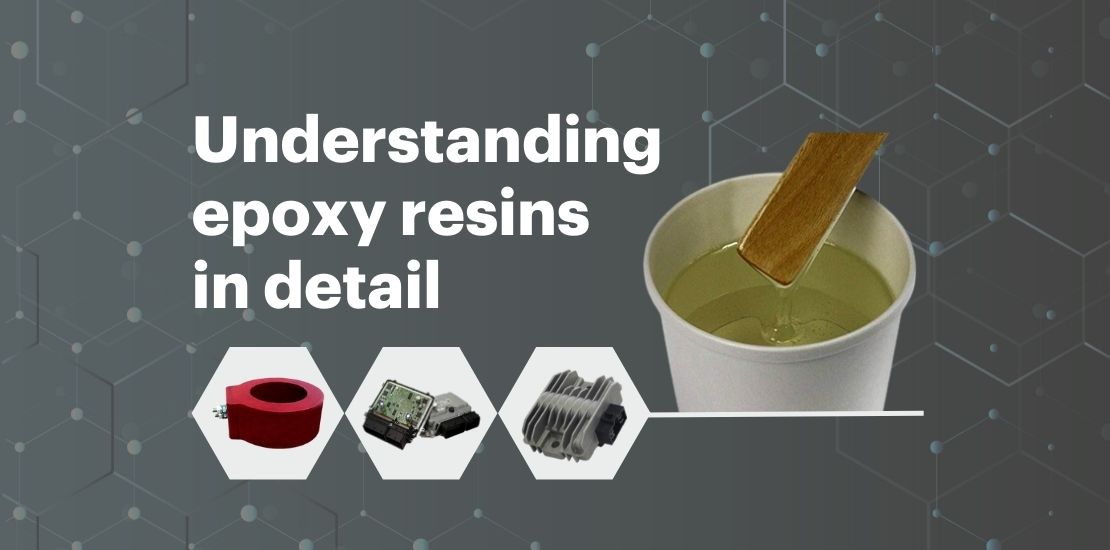Understanding the Composition of Epoxy Resins: A Comprehensive Guide
- May 5, 2022
- Posted by: veeyor@dmin
- Category: Epoxy resins

Epoxy resins are used widely across the industry for diverse purposes ranging from potting of electronic components, coating of mechanical or electronic parts as well as manufacturing. Typically, many components are coated or encapsulated with epoxies to protect these components from heat, mechanical shocks, and environmental elements.
Epoxy resins can be customized to obtain the desired properties for protection.
The present blog details the composition of epoxy resins and key considerations in mixing and potting the resins.
What are epoxy resins?
Epoxy resins are created by mixing two chemicals together: Resin and hardener. Proper mixing and curing of the resin are essential for obtaining the desired properties. Epoxy resins comprise a special type of polymers containing molecules with repetitive subunits. This structure of epoxy makes the resin highly durable and tough yet fairly elastic. These resins offer excellent resistance to heat and chemicals and have great adhesion properties.
After the resin and the hardener liquids are mixed, the resulting epoxy resin will undergo a process called curing to solidify itself. Curing takes anywhere between a few hours to a couple of days.
Veeyor Polymers is focused on research and development in epoxies and offers customized resins that can cure within the desired time span.
For perfect curing, the resin and hardener are mixed in a specific ratio. Typically the ratio is 1:1 or 1:2. When curing, epoxy resins generate considerable heat, which is known as exothermic effect. Keeping the resin temperature under control is essential for proper curing.
Explore how the exothermic effect impacts the quality of resins and ways to control the heat.
Types of epoxy resins
Epoxy resins are generally classified into 3 types
Pure epoxies:
Pure epoxy resins are the typical resins comprised of resin and hardener. They cure at a slower rate than the other two types of epoxies. Due to the slower curing, they shrink less, offer excellent adhesion properties, and possess high strength.
Polyester resins:
Polyester resins are synthetic resins in an unsaturated form. They are formed when organic acids react with polyhydric alcohols. Polyester resins cure through polymerization, and thus cure much faster than pure epoxy resins. The faster curation also makes these resins more suitable for low-temperature applications.
Epoxy acrylates:
Epoxy acrylate resins are a blend of pure epoxies and polyester resins. These resins are thus semi-polymeric substances that cure through polymerization. They are hard and durable and possess good resistance to abrasion and chemicals.
Significant properties of epoxy resins
- High resistance to chemicals
- Strong bonding with a wide range of substances
- Excellent tensile, flexural, and compressive strength
- Excellent electrical insulation
- Very little shrinking in the process of curing
- High resistance to corrosion
- High fatigue strength.
Epoxies are a preferred material in the industry due to their excellent resistance to heat and chemicals, and great adhesion properties. Compared to other conventional polymers, epoxies bring a number of advantages to the table.
Explore the advantages of epoxy resins in our blog here.
Factors to be considered when choosing epoxy resins
Epoxy resin offers protection to many critical parts and hence are immensely important for many applications. This is also the reason why epoxies might incur high costs. However, costs is not the only factor to consider when choosing epoxy resins. They must yield the desired chemical and mechanical properties, and hence, a number of aspects should be considered when choosing an epoxy resin
Mixing ratio
Mixing the resin and the hardener in the right measures is key to perfect curation. Follow the directions for mixing. For instance, tael top resins are to be mixed in 1:1 ratio with an equal amount of resin and hardener. The mixing ratio could differ as per the needs of your application. Many times, more hardener is added than the resin believing that it will lead the resin to cure faster. However, that is not the case. Instead, such actions might only disturb the consistency and chemical properties of the cured resin.
Curing time
The curing time of the epoxy resin impacts the performance of the final product, If the resin is poured in a thick layer, it will take more time to cure. For perfect curing, the resin temperature, and the temperature of the surroundings should also be considered.
Viscosity
Viscosity is the resistance to flow displayed by a liquid. Epoxy resins are available in high, medium, and low viscosity. Low viscosity resins are best suited for potting, impregnation, and encapsulation applications. Medium viscosity resins are more convenient to dispense and are used in sealing and bonding applications. High viscosity resins are used in applications where the epoxy must stay in place during the application as well as the curing process.
Do epoxies affect human health?
Epoxy resins could affect humans when touched. Additionally, many epoxies emit gasses such as carbon monoxide while curing. For better safety, adequate ventilation is advised during the curing process. Similarly, it is advised to wear protective clothing and eye protection while handling epoxies.
To learn about how to pot epoxies perfectly, explore the factors to consider while potting epoxies.
